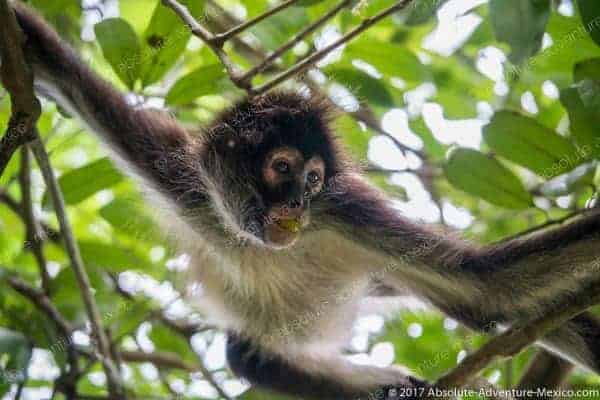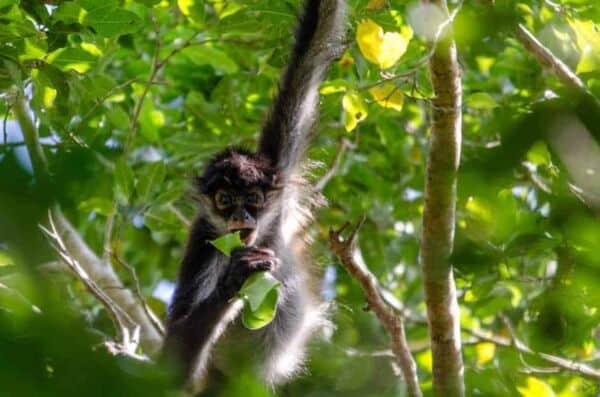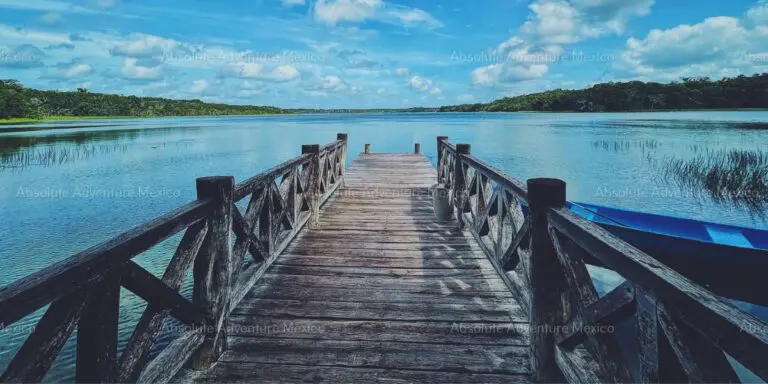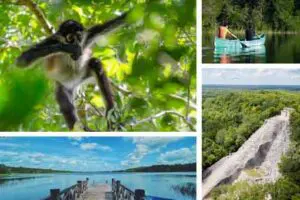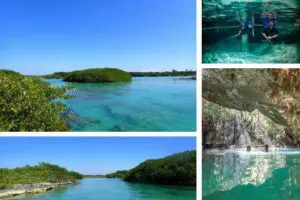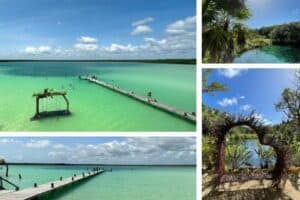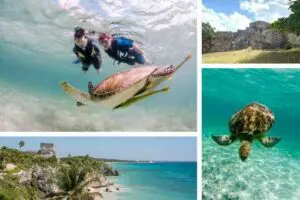Meet the Jungle’s Most Iconic Primates: Agile Spider Monkeys and Roaring Howler Monkeys
Monkeys are one of the most famous animals in the animal kingdom. We share a lot of things with them, from the skills to build a community, to the abilities to use different tools to get food.
On the Mexican Caribbean we have two species of them. You may see some of them, playing, getting close to you! This reminds us the importance of conservation… The best place to encounter monkeys during your stay in the Riviera is to go to the national park of Punta Laguna, a natural Monkey Sanctuary located next to Coba ruins.
Howler Monkeys, the loudest animals!
If you are lucky enough you will encounter or at least listen to the Howler Monkey, the loudest animal in the world (according the Record Guinness). It can be heard 2 miles away (3.2 km) in the jungle and almost 3 miles away (4.8 km) in open areas. They use this magnificent sound to delimit their territory from other troops and basically to them to back off.
Other facts about howling monkeys are:
- They are the second laziest animals in the wild (after the sloths). Spending the 80% of their time resting in the treetops.
- They live in groups of 10-20 individuals called “Troops”
- They are folivores (specialized in eating leaves)
- This specie has a trichromatic color vision, helping them to choose the best leaves for their diets
- Howling monkeys have a highly developed sense of smell- they can smell their food from 1-2 miles away
- The females help to take care of other young monkeys
Most of the howling monkey species are found in abundance in the wild. But Mexican howling monkeys are critical endangered due deforestation and development.
Spider monkeys, the strongest tail!
We have the loudest one but also the strongest tail one in the animal kingdom!
Spider monkeys are the acrobats of the trees! Their prehensile tail is longer than the rest of their body and can measure around 35 inches/90 cm in length. The tail is strong enough to support more than the animal’s body weight.
Some other interesting facts about spider monkeys are:
- They prefer to sleep in the trees to avoid predators, using the branches to alarm them in case of danger.
- They don’t posses thumbs to grasp branches better.
- Males raise the young ones.
- Spider Monkey´s diet mayor is ripe fruits and seeds.
- They are responsible for scattering seeds and are indirectly responsable in pollination.
- The mexican spider monkey is critical endangered due deforestastion and lost of the habitat.
If you want to have a chance to get around these monkeys, the best way is to get a tour to Punta Laguna, Monkey Sanctuary and help the local community to protect these species.
FAQ – Monkey Sanctuary at Punta Laguna
What is the Monkey Sanctuary at Punta Laguna?
The Monkey Sanctuary at Punta Laguna is a natural reserve and community-managed conservation area located in the jungle near Cobá.
It’s one of the best places in Mexico to observe wild spider monkeys in their native habitat, without cages or enclosures.
Are the monkeys at the sanctuary in the wild?
Yes. Punta Laguna is not a zoo—it’s a living jungle where monkeys roam free.
Local guides help visitors respectfully observe spider monkeys (and occasionally howler monkeys) in the trees during guided walks through the forest.
Is it ethical to visit this monkey sanctuary?
Absolutely. The Monkey Sanctuary at Punta Laguna is run by a local Maya cooperative that focuses on conservation, education, and sustainable tourism.
Your visit directly supports environmental protection and community development.
What kind of monkeys can I see at the sanctuary?
The most common species you’ll see are Geoffroy’s spider monkeys, known for their long limbs and playful behavior.
With luck, you might also hear or spot howler monkeys, known for their deep, echoing calls.
Can I feed or touch the monkeys?
No. As a true wildlife sanctuary, Punta Laguna promotes respectful observation.
The monkeys are wild and not habituated to human contact—feeding or touching them is not allowed to ensure their safety and yours.
Do I need a guide to explore the monkey sanctuary?
Yes, guided tours are required for entering the forested areas where monkeys live.
The local guides are skilled at spotting wildlife and will share insight into the jungle ecosystem, Maya traditions, and the animals’ behavior.
When is the best time to visit Punta Laguna?
The best time to spot monkeys is in the early morning or late afternoon, when they are more active.
Punta Laguna is open year-round, although opening hours and activity availability may vary slightly depending on the season or weather.
Is this monkey sanctuary good for kids and families?
Definitely. The experience is both fun and educational for all ages. Children especially enjoy the jungle trails, spotting monkeys in the treetops, and optional activities like canoeing or cenote swimming.
How can I visit the monkey sanctuary at Punta Laguna?
The best way to visit is on a private tour that includes round-trip transportation, entrance fees, and a certified guide. From Tulum or Playa del Carmen, it’s an easy day trip into the jungle.
What should I wear and bring?
We recommend wearing comfortable clothes, closed walking shoes, and a swimsuit if you plan to swim in the cenote.
Don’t forget biodegradable insect repellent, sunscreen, and a refillable water bottle.
A camera or binoculars is great for wildlife viewing.



